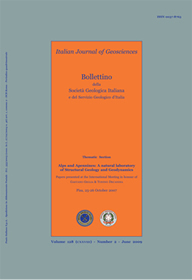
Stratigrafia della Formazione del Ponticello (Miocene superiore, Appennino campano)
Sabatino Ciarcia(*), Mario Torre(*) & Tommaso Mitrano(*)
(*) Dipartimento di Scienze della Terra, Università degli Studi
di Napoli «Federico II», Largo S. Marcellino, 10 - 80138 Napoli
(e-mail: sciarcia@unina.it; martorre@unina.it; tmitrano@tiscali.it)
Volume: 128 (2009) f.3
Pages: 715-721
Abstract
The Ponticello formation is represented by a siliciclastic and calciclastic sedimentary succession, outcropping in the campanian sector of the Southern Apennines, and structured in four main sequences (lithozones). A transition interval is localized in the upper portion of the sedimentary record.
A lithozone CTS (Calcarenitic Turbiditic Sequence), with dominant marly deposits is constituted by yellow, medium, sometimes coarse grained stratified calcarenites, occasionally weakly cemented. The bed thickness varies from a few centimeters to several decimeters, with many showing the Bouma Sequence. In the Arenara and Melito Vecchia locations frequent intervals of marls, marly limestones, and rarely «pseudo-saccharoidal» limestones crop out. An intense bioturbation is present. The deposits of this interval are approximately 25 meters thick and originated by turbiditic processes.
A lithozone SCS (Sandy-microConglomeratic Sequence), with dominant arenaceous-conglomeratic deposits, comprises alternations of medium-coarse grained yellow-brownish sands with quartzo-feldspathic composition, and paraconglomerates. In places this interval includes some layers of granular conglomerates, with sub-rounded polygenic clasts, immersed in a sandy matrix. The sands are organized in layers some decimetres thick. The paraconglomerates are usually organized in fining-up sequences. The thickness of this lithozone is approximately 40 meters, the significant exposures being in the Vallone dei Morti. The deposits of this lithozone can be interpreted as formed by submarine mass flows and gravity flows.
A lithozone MCS (Marly-Calcareous Sequence), with marly-limestone dominant, consists of alternations of marls, calcareous marls and white marly limestones, ordered in layers which generally have a maximum thickness of 10-15 centimeters, and usually contain an abundant planktonic microfauna. The thickness of this lithozone seems to exceed 50 meters in the Incoronata and Felette locations. The sediments of this interval can be considered as the result of depositional processes that occur along a submarine slope.
Above the lithozone MCS lies a transitional stratigraphic interval, well exposed along the Vallone Ponticello, and characterized by two dominant components: a calciclastic portion (TCC), in the lower part, and a siliciclastic fraction (TSC), in the upper part. The lower part, about 20 meters thick, crops out in the C. Sterpara and Pretalonga locations, shows alternations of partially recrystallized calcarenites and calcareous brecciola. This last lithotype is characterized by lithoclastic (calcilutites, oolithic limestones, etc.) and bioclastic (Lithothamnium and briozoarians, pectinids, etc.) elements, granule to fine pebble size and frequently angular-shaped, inter-bedded with marly limestones and marls. In the C. Sterpara location, the upper transition interval (TSC), approximately 25 meters thick, also outcrops. It is constituted by sandstones, siltstones and marls, with very frequent intercalations of alternating of light grey muddy marls and brownish muddy silts, outcropping in Incoronata location. Here a polygenetic orthoconglomerate horizon more than one meter thick is present, containing an important crystalline fraction (mostly granitoids). The clast dimensions are commonly larger than ten centimetres, the sorting is moderate, and a short supply of the arenaceous-microconglomeratic matrix is manifest. The transition interval can be interpreted as connected to processes of detritic sedimentation in proximal sectors of the marine basin, near the coastline.
A lithozone ATS (Arenaceous Turbiditic Sequence) with arenaceous-pelitic compositions dominant, consists of brownish-yellow, [or yellowish-brown!] medium to fine grained, quartzo-feldspathic sandstones and laminated muds. Usually the complete Bouma Sequence is recognizable. The best exposure is in the C. Sterpara location, where this interval reaches a thickness of approximately 30 meters. This interval can be interpreted as the result of submarine turbiditic flows.
The planktonic foraminifera (biozone G. o. extremus) and nannoplankton (biozone CN9a) associations indicate a middle-upper Tortonian age.
The calciclastic fraction originates from the erosion of several units of the Southern Apennine chain. The supply areas of the calcareous clasts are identifiable with the Mesozoic carbonate platform unit, mainly from outer positions. In the lower part of the transition interval (TCC) the presence of fragments of limestones with Lithothamnium and briozoarians indicates the probable erosion of Miocene successions (Formazione di Cusano and Formazione di Longano, SELLI, 1957) overlying some external platforms.
The source areas of the siliciclastic sediments, instead, derive from the erosion of deposits previously involved in the orogenic transport. The rich presence of crystalline clasts in the upper portion of the transition interval (TSC), is due to probable reworking of inner units of the sudappennine chain (cfr. Gruppo del Cilento, AMORE et alii, 1988).
The supra-Miocene deposits of the Ponticello Formation are the expression of an intermontane basin, carried on the Southern Apennine nappes, in thrust-top position.
Keywords
Get Full Text